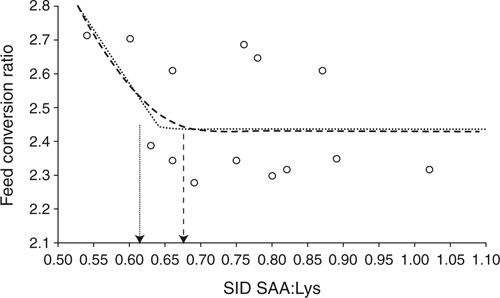Sulphur amino acid requirements of commercially-grown finisher pigs
J. C. Kim A E , C. L. Collins B , J. L. Black C , K. L. Moore A , M. Trezona A , B. P. Mullan A and J. R. Pluske DA Department of Agriculture and Food, South Perth, WA 6151.
B Rivalea (Australia), Corowa, NSW 2646.
C John L Black Consulting, Warrimoo, NSW 2774.
D Murdoch University, Murdoch, WA 6150.
E Corresponding author. Email: jae.kim@agric.wa.gov.au
Animal Production Science 55(12) 1564-1564 https://doi.org/10.1071/ANv55n12Ab090
Published: 11 November 2015
Reduced protein utilisation in immune-system-activated pigs is caused primarily by an enhanced rate of protein turnover associated with additional production of immune cells, antibodies and acute phase proteins, which are particularly high in sulphur amino acids (SAA) (Rakhshandeh and de Lange 2011). The current study tested the hypothesis that the SAA requirements of finisher pigs grown commercially will be greater than the current NRC (2012) recommendation of 0.58 standardised ileal digestible SAA to lysine (Lys) ratio (SID SAA:Lys), on the basis that pigs grown commercially are continuously exposed to high microbial loads and environmental challenges.
Two commercial experiments were conducted. A total of 2016 group-housed pigs (Large White × Landrace, PrimeGro Genetics) were selected at 50.1 ± 0.46 kg (mean ± SE) and allocated to diets containing SID SAA:Lys ratios of 0.54, 0.60, 0.63, 0.66, 0.69, 0.75, 0.76, 0.78, 0.80, 0.82, 0.87, 0.89, and 1.02. Experiments 1 and 2 used 12 and 8 replicate pens (containing 14 pigs) per treatment, respectively. Diets used for Experiment 1 and 2 contained 13.8 MJ digestible energy (DE)/kg and 0.55 g SID Lys, and 14.0 MJ DE/kg and 0.56 g SID Lys per kg, respectively. Pigs were fed the experimental diets for 6 weeks and performance was recorded. Data were analysed using REML variance component analysis with the experimental batches and replicate pens set as random factors. Data means were then fitted to the linear-plateau and quadratic plateau models to estimate SID SAA requirements using the Nutritional Response Models 1.1 (Vedenov and Pesti 2008).
The minimum feed conversion ratio (FCR) was achieved at SID SAA:Lys ratios of 0.64 (SE ± 0.29) and 0.71 (SE ± 0.30) for linear-plateau and quadratic-plateau prediction models, respectively (Fig. 1). Increasing the SID SAA:Lys ratio showed no LP or QP responses to growth rate, however average daily feed intake (ADFI) was decreased in a comparable manner to FCR (data not shown). These data suggest that (1) increasing the dietary SID SAA:Lys ratios decreased ADFI but maintained daily growth rate via improvements in FCR, and (2) the requirement for dietary SID SAA:Lys for commercially-grown finisher pigs was not significantly different from the current NRC (2012) estimate, and the high variation in the estimate illustrates the difficulty with conducting research under commercial conditions.

|
References
NRC (2012) ‘Nutrient requirements of swine.’ 11th edn. (National Academy Press: Washington, DC)Rakhshandeh A, de Lange CFM (2011) Australasian Pig Science Association Manipulating Pig Production XIII, 31–46, ed RJ van Barneveld).
Vedenov D, Pesti G (2008) Journal of Animal Science 86, 500–507.
| Crossref | GoogleScholarGoogle Scholar |
Supported in part by Pork CRC Limited Australia.


